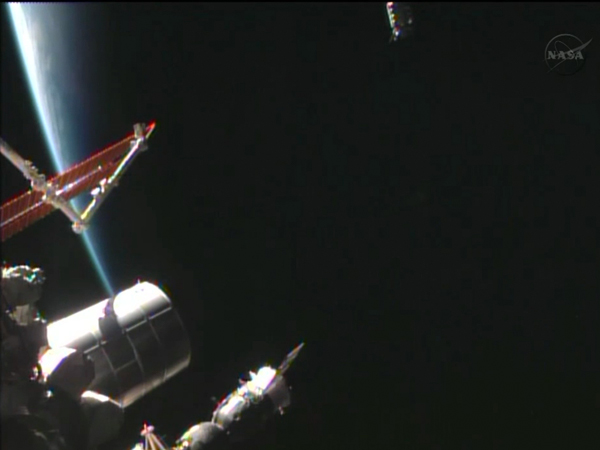New commercial supply ship reaches space station

This framegrabbed image provided by NASA-TV shows the Cygnus spacecraft, top, as it approaches the International Space Station, lower left, with the curvature of the earth in the background Sunday Sept. 29, 2013. AP
CAPE CANAVERAL, Florida—NASA’s newest delivery service made its first-ever shipment to the International Space Station on Sunday, another triumph for the booming commercial space arena that has its sights set on launching astronauts.
Orbital Sciences Corp.’s unmanned cargo ship, the Cygnus, pulled up at the orbiting lab with a half-ton of meals and special treats for the station astronauts who assisted in the high-flying feat.
With the smooth linkup, Orbital Sciences of Virginia became only the second company to accomplish such a far-flung shipment. The California-based SpaceX company took the lead last year.
NASA officials along with White House representatives declared it a historic day.
“It was just a very, very impressive job … I just couldn’t be happier and more proud,” said the NASA manager overseeing this commercial effort, Alan Lindenmoyer.
Now that the space station has two US private companies capable of delivering goods, he noted, “it’s certainly relief and something we’re ready to celebrate.”
All this was a week late in coming.
The Cygnus—named after the swan constellation—should have arrived last Sunday, four days following its launch from Virginia on Sept. 18. But a discrepancy in navigation data between the capsule and the space station led to a frustrating standoff. A simple software repair was carried out by ground controllers. Then the Cygnus had to wait for a Russian spacecraft to bring three new astronauts.
The wait involved “some hair-pulling and heartache,” said Orbital Sciences executive vice president Frank Culbertson. But in the end, the company’s patience was rewarded with a perfect rendezvous demonstration.
Applause could be heard in Mission Control once Italian astronaut Luca Parmitano grabbed hold of Cygnus with the space station’s hulking mechanical arm. The union occurred 260 miles (420 kilometers) above the Indian Ocean. Before long, the capsule was latched securely to the orbiting lab. Its hatch will remain closed until early Monday; that’s when the six station astronauts will enter the capsule and begin unloading the bounty.
The successful arrival means Orbital Sciences can start making good on a $1.9 billion contract with NASA for more Cygnus deliveries, each one carrying more and more cargo. The next one could fly by Christmas.
“We have a big incentive ahead of us,” said Culbertson, a former astronaut who lived on the space station a decade ago.
John Holdren, assistant to President Barack Obama for science and technology, said Sunday’s success validates the president’s goal of focusing NASA on deep-space exploration and leaving station cargo and astronaut hauls to private industry.
“Space history was made again today,” Holdren said in a statement.
Sunday’s operation culminated several years of effort for Orbital Sciences, which was hired by NASA along with SpaceX—formally Space Exploration Technologies Corp.—to keep the space station well stocked in this post-shuttle era.
SpaceX has been launching its supply ships, called Dragon, from Cape Canaveral for more than a year. It’s also working on a possible manned capsule that would ferry US astronauts to the space station, rather than having them hitch rides on Russian rockets. The cargo contract alone, with NASA, is worth $1.6 billion.
From Southern California on Sunday, as Orbital Sciences celebrated its own victory, SpaceX launched a beefed-up Falcon 9 rocket with a Canadian science satellite. The demo flight appeared to go well.
Unlike the SpaceX Dragon that can return items to Earth, the Cygnus is designed to burn up upon descent. Once unloaded of its 1,300 pounds (590 kilograms) worth of food, clothes and other items, it will be filled with trash and cut loose on Oct. 22. That’s how the Russian, European and Japanese supply ships end up as well: self-destructing garbage cans.
The latest Cygnus delivery—also a test flight—included student experiments and, almost certainly, chocolate for the crew. That’s what astronaut Karen Nyberg was expecting, anyway, from her astronaut-husband and 3-year-old son.
Both the station crew and Mission Control paid tribute to the late astronaut for whom the Cygnus is dedicated: G. David Low.
Low flew three times on space shuttles, then went to work for Orbital Sciences to help in this new commercial space effort. He died of cancer in 2008 at age 52. His family attended the Cygnus launch from NASA’s Wallops Flight Facility.
“To our great friend and colleague G. David Low. … This one’s for you,” Orbital Sciences said via Twitter.—Marcia Dunn